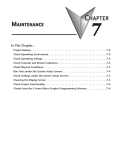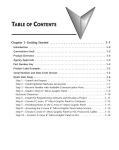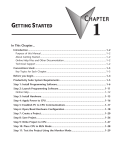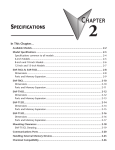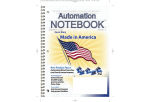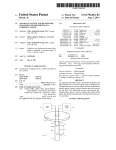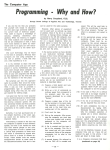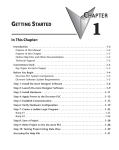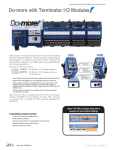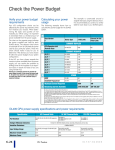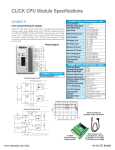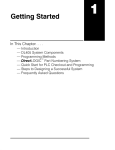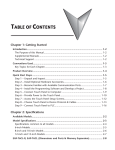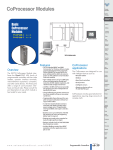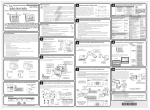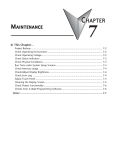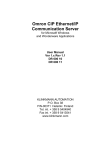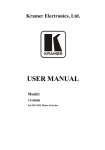Download Chapter 1- Getting Started:Chapter 1
Transcript
GETTING STARTED CHAPTER 1 In This Chapter... Introduction . . . . . . . . . . . . . . . . . . . . . . . . . . . . . . . . . . . . . . . . . . . . . . . . . . . . . . .1–2 Purpose of this Manual . . . . . . . . . . . . . . . . . . . . . . . . . . . . . . . . . . . . . . . . . . . . . .1–2 About Getting Started . . . . . . . . . . . . . . . . . . . . . . . . . . . . . . . . . . . . . . . . . . . . . . .1–2 Online Help Files and Other Documentation . . . . . . . . . . . . . . . . . . . . . . . . . . . . . .1–2 Technical Support . . . . . . . . . . . . . . . . . . . . . . . . . . . . . . . . . . . . . . . . . . . . . . . . . .1–2 Conventions Used . . . . . . . . . . . . . . . . . . . . . . . . . . . . . . . . . . . . . . . . . . . . . . . . . . .1–3 Key Topics for Each Chapter . . . . . . . . . . . . . . . . . . . . . . . . . . . . . . . . . . . . . . . . . .1–3 Before you begin... . . . . . . . . . . . . . . . . . . . . . . . . . . . . . . . . . . . . . . . . . . . . . . . . . .1–4 Productivity Suite System Requirements . . . . . . . . . . . . . . . . . . . . . . . . . . . . . . . . .1–5 Step 1: Install Programming Software . . . . . . . . . . . . . . . . . . . . . . . . . . . . . . . . . . .1–6 Step 2: Launch Programming Software . . . . . . . . . . . . . . . . . . . . . . . . . . . . . . . . .1–11 Online Help . . . . . . . . . . . . . . . . . . . . . . . . . . . . . . . . . . . . . . . . . . . . . . . . . . . . . .1–12 Step 3: Install Hardware . . . . . . . . . . . . . . . . . . . . . . . . . . . . . . . . . . . . . . . . . . . . .1–13 Step 4: Apply Power to PAC . . . . . . . . . . . . . . . . . . . . . . . . . . . . . . . . . . . . . . . . . .1–16 Step 5: Establish PC to PAC Communications . . . . . . . . . . . . . . . . . . . . . . . . . . . .1–17 Step 6: Open/Read Hardware Configuration . . . . . . . . . . . . . . . . . . . . . . . . . . . .1–18 Step 7: Create a Project . . . . . . . . . . . . . . . . . . . . . . . . . . . . . . . . . . . . . . . . . . . . .1–20 Step 8: Save Project . . . . . . . . . . . . . . . . . . . . . . . . . . . . . . . . . . . . . . . . . . . . . . . .1–26 Step 9: Write Project to PAC . . . . . . . . . . . . . . . . . . . . . . . . . . . . . . . . . . . . . . . . . .1–27 Step 10: Place PAC in RUN Mode . . . . . . . . . . . . . . . . . . . . . . . . . . . . . . . . . . . . . .1–28 Step 11: Test the Project Using the Monitor Mode . . . . . . . . . . . . . . . . . . . . . . . .1–29 Chapter 1: Getting Started Introduction 1 2 3 4 5 6 7 8 9 10 11 12 13 14 A B C D Purpose of this Manual Thank you for purchasing the AutomationDirect Productivity3000 Programmable Automation Controller (PAC) family of products. This hardware user manual provides information that will help you install, set up, program, troubleshoot, and maintain your Productivity3000 PAC system. The manual includes information that is critical to the safety of the personnel who will install and use the controller and to the machinery, processes, and equipment controlled by the PAC. The manual also includes important information about power and signal wiring, mounting of the PAC, and configuring the PAC system. About Getting Started If you are familiar with Programmable Controllers in general, then following the simple steps in this first chapter may be all you require to start being productive using a Productivity3000 PAC system. After you have completed the steps, your Productivity3000 controller will be running the ladder logic project that you programmed. Online Help Files and Other Documentation The Productivity3000 programming software, Productivity Suite, is available as a download from our website. See http://www.aboutplcs.com/ The Productivity Suite software includes searchable online help topics covering all aspects of the software, instruction set, module setup, and communications. In addition, each base, power supply, CPU, and I/O module includes an installation insert. Technical Support We strive to make our manuals the best in the industry. We rely on your feedback to let us know if we are reaching our goal. If you cannot find the solution to your particular application, or, if for any reason you need technical assistance, please call us at: 770–844–4200 Our technical support group will work with you to answer your questions. They are available Monday through Friday from 9:00 A.M. to 6:00 P.M. Eastern Time. We also encourage you to visit our web site where you can find technical and non-technical information about our products and our company. http://www.automationdirect.com 1–2 Hardware User Manual, 4th Edition, Rev. B Chapter 1: Getting Started Conventions Used When you see the “note pad” icon in the left-hand margin, the paragraph to its immediate right will be a special note. Notes represent information that may make your work quicker or more efficient. The word NOTE: in boldface will mark the beginning of the text. When you see the “exclamation point” icon in the left-hand margin, the paragraph to its immediate right will be a warning. This information could prevent injury, loss of property, or even death in extreme cases. Any warning in this manual should be regarded as critical information that should be read in its entirety. The word WARNING in boldface will mark the beginning of the text. Key Topics for Each Chapter The beginning of each chapter will list the key topics that can be found in that chapter. Getting Started! CHAPTER 1 In This Chapter... Introduction .............................................................................1-2 Purpose of this Manual ....................................................................1-2 About Getting Started! ......................................................................1-2 Supplemental Manuals and Other Help ............................................1-2 Technical Support .............................................................................1-2 Conventions Used ....................................................................1-3 Hardware User Manual, 4th Edition, Rev. B 1–3 1 2 3 4 5 6 7 8 9 10 11 12 13 14 A B C D Chapter 1: Getting Started Before you begin... 1 2 3 4 5 6 7 8 9 10 11 12 13 14 A B C D It is recommended that the following items be available to make this short step-by-step introduction to the Productivity3000 PAC go smoothly. Example Productivity3000 System P3-03B Base P3-FILL Module P3-01AC or P3-01DC Power Supply P3-08TAS Output Module P3-550 CPU Module P3-16SIM Module (P3-530 CPU Module is also available) PC Running Vista or Windows 7 Not available from Automationdirect.com. Productivity Suite Programming Software P3-PGMSW Download software from our webste at: www.productivitypac.com USB-A to USB-B Programming Cable (P3-550 only) If using the P3-530 CPU, then use an Ethernet cable for programming. Refer to the help file for information on Ethernet communication set up procedures AC Power Cord Screwdriver DN-SS1 Wire Strippers DN-WS Hookup Wire Not available from Automationdirect.com. 1–4 Hardware User Manual, 4th Edition, Rev. B Chapter 1: Getting Started Productivity Suite System Requirements Productivity Suite Windows-based programming software works with Windows® XP (Home or Professional), Vista (Home, Basic, Premium, 32 or 64-bit) or Windows 7 (Home, Professional, Ultimate, 32 or 64-bit). The Productivity Suite Programming Software includes a software installation guide and CD-ROM. Please check the following requirements when choosing your PC configuration: • Windows XP Personal Computer with a 333 MHz or higher processor (CPU) clock speed recommended; Intel Pentium/Celeron family or AMD K6/Athlon/Duron family, or compatible processor recommended. • Vista or Windows 7 Personal Computer with a 800 MHz or higher processor (CPU) clock speed recommended; Intel Pentium/Celeron family or AMD K6/Athlon/Duron family, or compatible processor recommended. • SVGA 1024x768 pixels resolution. (1280x1024 pixels resolution recommended). • 300MB free hard-disk space. • RAM: Windows XP; 128MB free RAM (512MB recommended). Vista or Windows 7; 512MB free RAM (1GB recommended). • CD-ROM or DVD drive for installing software from the CD. • USB or Ethernet Port for project transfer to PAC. NOTE: USB or Ethernet cable is also required for communications between PC and PAC. Hardware User Manual, 4th Edition, Rev. B 1–5 1 2 3 4 5 6 7 8 9 10 11 12 13 14 A B C D Chapter 1: Getting Started Step 1: Install Programming Software 1. Download the latest version of the Productivity Suite Programming Software from: 1 2 3 4 5 6 7 8 9 10 11 12 13 14 A B C D www.productivitypac.com Or, if the Installation CD is available, insert the Productivity Suite Programming Software CD into the PC’s CD drive. The splash screen should appear after a short time. 2. Click on the splash screen’s Install button and follow the dialog boxes. 3. If the CD does not auto-run, click your PC’s Start menu (bottom left corner of screen), and select Run or for Windows 7 users, type "run" in the search field to locate this application. • Type the following in the Open text field: D: install.exe, where D: is the drive letter of the CD drive being used, or browse to the location of the “install.exe” file that was downloaded and select this file. • Select OK and follow the dialog boxes shown through the next pages. NOTE: See the Productivity Suite Installation and Productivity Suite Startup topics for additional details if needed. 4. Carefully read the software license agreement. If you agree to the terms and conditions of this agreement, select the “I accept the terms of this License Agreement” and then the "Next" button. 1–6 Hardware User Manual, 4th Edition, Rev. B Chapter 1: Getting Started 5. The Choose Install Folder window will open next. If this is the first installation of the Productivity Suite Software on your PC, the window shown below will open. You may accept the default install location or choose a different one using the Browse button. The default location is C:\Program Files\AutomationDirect\Productivity Suite <Software Version>. If the installer detects a previous version of Productivity Suite on your PC, then the following window will be displayed in place of the one above. There are two options available with this Choose Install Folder window: a. Install a New Instance: This option will install a new instance of the Productivity Suite software in the specified folder. b. Replace the Existing Instance: This option allows you to uninstall the previous version of the software and install the new version in its place. If this option is chosen the following window appears. Click Uninstall to continue. Hardware User Manual, 4th Edition, Rev. B 1–7 1 2 3 4 5 6 7 8 9 10 11 12 13 14 A B C D Chapter 1: Getting Started 1 2 3 4 5 6 7 8 9 10 11 12 13 14 A B C D 6. Once you have selected the install folder and whether or not to delete any previous instances, the Choose Shortcuts window below will appear. If a Shortcut Icon is desired for the software select the location where the icon will be created. The default location is On the Desktop . Once all selections have been made, click Install to begin the installation. A status window will appear displaying the status of the installation. 1–8 Hardware User Manual, 4th Edition, Rev. B Chapter 1: Getting Started 7. Do you want to install DataWorx P3K Software? DataWorx P3K runs on a network PC and acts as a translator between the Productivity3000 and SQL databases. If you select Yes, an evaluation version of DataWorx P3K will also install on your computer. The evaluation version allows full functionality, but is limited to 30 minute sessions. Separate database software is required, but is not included. See our website for more information on DataWorx P3K. Choose Yes or No and select "Next". Hardware User Manual, 4th Edition, Rev. B 1–9 1 2 3 4 5 6 7 8 9 10 11 12 13 14 A B C D Chapter 1: Getting Started 1 2 3 4 5 6 7 8 9 10 11 12 13 14 A B C D 8. The next screen to appear contains the Release Notes for this version of the Productivity Suite software. 9. The Installation is now complete. Select "Done". 1–10 Hardware User Manual, 4th Edition, Rev. B Chapter 1: Getting Started Step 2: Launch Programming Software After installing the Productivity Suite Programming Software, P3-PGMSW, launch the software by double clicking the desktop Productivity Suite Icon . Or from the PC’s ‘start’ menu, slide the mouse pointer through the menus (start>All Programs>AutomationDirect>Productivity Suite x.x.x.x>Productivity Suite) to the Productivity Suite Programming Software selection, and use the left mouse button to click on it. The Productivity Suite Programming Software will start up and display the Main Window as shown here. NOTE: The recommended minimum screen size for the Productivity Suite Software is 1024 X 786 pixels. Click on the ‘New Project’ in the Start Project dialog box to open a programming window. Hardware User Manual, 4th Edition, Rev. B 1–11 1 2 3 4 5 6 7 8 9 10 11 12 13 14 A B C D Chapter 1: Getting Started 1 2 3 4 5 6 7 8 9 10 11 12 13 14 A B C D The Programming Window is divided into menus and toolbars that work together to make project development as simple as possible. Online Help It is essential that you use the Productivity Suite online Help to familiarize yourself with the software. Keep it open on your desktop and refer to it frequently as you build your system. Click on the toolbar Help button to open the Help file. 1–12 Hardware User Manual, 4th Edition, Rev. B Chapter 1: Getting Started Step 3: Install Hardware The Productivity3000 PAC system components snap together to form a configured PAC in minutes. See Chapter 5, Installation and Wiring, for more detailed hardware installation information, but these are the basic steps: 1. Install power supply in the base and engage locking tabs. Locking Tabs 2. Install CPU in the base and engage locking tab. Hardware User Manual, 4th Edition, Rev. B 1–13 1 2 3 4 5 6 7 8 9 10 11 12 13 14 A B C D Chapter 1: Getting Started 3. Install I/O Modules and engage locking tabs. 1 2 3 4 5 6 7 8 9 10 11 12 13 14 A B C D 4..Connect appropriate wiring to power supply and I/O, a P3-01AC and P3-08TAS in this example. In this case, The power supply and load are being connected to an AC current source. ACL ACN LOGIC GND Power Supply 1–14 ACL To Load Load Hardware User Manual, 4th Edition, Rev. B Chapter 1: Getting Started 5. Connect USB cable (P3-550 only). Use a standard USB cable with Type A and Type B connectors as shown below. If using the P3-530, connect a standard Ethernet cable from the PC to the PAC CPU. Hardware User Manual, 4th Edition, Rev. B 1–15 1 2 3 4 5 6 7 8 9 10 11 12 13 14 A B C D Chapter 1: Getting Started 1 2 3 4 5 6 7 8 9 10 11 12 13 14 A B C D Step 4: Apply Power to PAC Ensure proper wiring has been made to the PAC and the correct voltage is available before applying power to the PAC. Once this is verified, apply power to the PAC. The PAC will perform a self evaluation and verification when power is applied. See Chapters 2 and 5 of this manual for more power supply and input wiring information. 1–16 Hardware User Manual, 4th Edition, Rev. B Chapter 1: Getting Started Step 5: Establish PC to PAC Communications Select the Choose PAC Icon on the Control PAC Toolbar and the dialog shown below will appear. Highlight the PAC listed in the dialog box and select “Connect”. When initially going Online with the PAC, a popup window will notify you of a project difference between the PAC and the PC. Select "No, Use PC Project". Hardware User Manual, 4th Edition, Rev. B 1–17 1 2 3 4 5 6 7 8 9 10 11 12 13 14 A B C D Chapter 1: Getting Started 1 2 3 4 5 6 7 8 9 10 11 12 13 14 A B C D Step 6: Open/Read Hardware Configuration Before we create a project we must configure the hardware so we’ll have the input and output tags. With the PAC in STOP Mode, select Hardware Configuration under Application Tools and the following screen opens. 1–18 Hardware User Manual, 4th Edition, Rev. B Chapter 1: Getting Started This screen shows the user tag names for all eight I/O points. Select OK. 1 2 3 4 5 6 7 8 9 10 11 12 13 14 A B C D Hardware User Manual, 4th Edition, Rev. B 1–19 Chapter 1: Getting Started 1 2 3 4 5 6 7 8 9 10 11 12 13 14 A B C D Step 7: Create a Project We’re going to start entering a simple example ladder logic program in the order that follows. Rung #1 Place the box cursor on the END position on Rung #1 as shown below. From the Instructions List, scroll down to Counters/Timers, and click & drag a Simple Timer (STMR) into this box. A Simple Timer (STMR) dialog box pops up. 1. Enter ‘300’ (0.01 sec timebase) into the Preset Value text box for a 3 second preset, 2. Enter ‘T1_CURVAL’ into the Current Value test box, 3. Enter ‘T1_DN’ into the Done text box. 4. Select OK. The Define Tags dialog box opens. Select OK. 1–20 Hardware User Manual, 4th Edition, Rev. B Chapter 1: Getting Started Place the Box Cursor on the first position on Rung #1 as shown below. From the Instruction List, scroll to Contact, and click & drag a Contact (NO) into this box. A NO Contact (NO) dialog box pops up. 1. Enter ‘T1_Start’ into the text box. 2. Select OK. The Define Tags dialog box opens. Select OK. Hardware User Manual, 4th Edition, Rev. B 1–21 1 2 3 4 5 6 7 8 9 10 11 12 13 14 A B C D Chapter 1: Getting Started With the cursor in the position to the right of contact ‘T1_Start’, we are going to begin drawing a branch circuit. Under the Edit drop down menu, select Wire, then select Down. Notice that a wire has been added. 1 2 3 4 5 6 7 8 9 10 11 12 13 14 A B C D NOTE: There is also a wire Erase With Cursor tool in the Edit drop down menu that is used to erase any lines that were created using the Wire tools. 1–22 Hardware User Manual, 4th Edition, Rev. B Chapter 1: Getting Started Next we’ll draw a wire to the left. Under the Edit drop down menu, select Wire, then select Left. Next we’ll add another normally-open contact. Place the box cursor on the first position on Rung #1.1. From the Instruction List click & drag a Contact (NO) into this box. A NO Contact (NO) dialog box pops up. 1. Enter ‘T1_Manual’ into the text box. 2. Select OK. The Define Tags dialog box opens. Select OK. Hardware User Manual, 4th Edition, Rev. B 1–23 1 2 3 4 5 6 7 8 9 10 11 12 13 14 A B C D Chapter 1: Getting Started 1 2 3 4 5 6 7 8 9 10 11 12 13 14 A B C D Rung #2 Next we’ll add another normally-open contact at the start of rung 2. Click & drag a Contact (NO) into this box. A NO Contact (NO) dialog box pops up. 1. In the text box scroll down and select ‘T1_DN’. 2. Select OK. Next we’ll add an Out coil at the end of the rung. Place the cursor at the end of the rung, and from the Instructions list drag & drop an Out Coil (OUT). An Out Coil (OUT) dialog box pops up. 1. In the text box scroll down and select ‘DO-0.1.2.1’. 2. Select OK. 1–24 Hardware User Manual, 4th Edition, Rev. B Chapter 1: Getting Started The ladder program now looks like this. When either of the T1 contacts are energized, the timer starts. When it times out, contact T1_DN energizes and turns on the rung 2 output. Hardware User Manual, 4th Edition, Rev. B 1–25 1 2 3 4 5 6 7 8 9 10 11 12 13 14 A B C D Chapter 1: Getting Started 1 2 3 4 5 6 7 8 9 10 11 12 13 14 A B C D Step 8: Save Project Save the project by opening the File drop-down menu and selecting Save Project. 1–26 Hardware User Manual, 4th Edition, Rev. B Chapter 1: Getting Started Step 9: Write Project to PAC Next we will transfer the project to the PAC. Transfer Project is accessed by selecting Transfer Project from the File Menu of the Main Menu. Select "To PAC" from the Transfer Project menu. The project will then be Transferred to the PAC from the PC. During the transfer a status window will open displaying the process. Hardware User Manual, 4th Edition, Rev. B 1–27 1 2 3 4 5 6 7 8 9 10 11 12 13 14 A B C D Chapter 1: Getting Started 1 2 3 4 5 6 7 8 9 10 11 12 13 14 A B C D Step 10: Place PAC in RUN Mode Next, verify the Run/Stop switch on the PAC CPU is placed to the Run position and then place the PAC in RUN mode on the Control PAC Toolbar so the ladder logic program executes. NOTE: If the Run/Stop switch on the PAC is in the Stop position, the Run button on the Control PAC Toolbar will be disabled. jjjjjjjjjjjjjjjjjjjjjjjjjjjjjjjjjjjjjjjjjjjjjjjjjjjjjjjjjjjjjjjjjjjjjjjjjjjjjjjjjjjjjjjjjjjjjjjjjjjjjjjjjjjjjjjjjjjjjjjjjjjjjjjjjjjjjjjjjjjjjjjjjjjjjjjjjjjjjjjjjjjjjjjjjjjjjjjjjjjjjjjjjjjjjjjj jjjjjjjjjjjjjjjjjjjjjjjjjjjjjjjjjjjjjjjjjjjjjjjjjjjjjjjjjjjjjjjjjjjjjjjjjjjjjjjjjjjjjjjjjjjjjjjjjjjjjjjjjjjjjjjjjjjjjjjjjjjjjjjjjjjjjjjjjjjjjjjjjjjjjjjjjjjjjjjjjjjjjjjjjjjjjjjjjjjjjjjjjjjjjjjj jjjjjjjjjjjjjjjjjjjjjjjjjjjjjjjjjjjjjjjjjjjjjjjjjjjjjjjjjjjjjjjjjjjjjjjjjjjjjjjjjjjj 1–28 Hardware User Manual, 4th Edition, Rev. B Chapter 1: Getting Started Step 11: Test the Project Using Monitor Mode In this next step, use the Monitor Mode and Data View to test the ladder logic program. Select Monitor Mode from the top of the Ladder Logic screen to display the status of Boolean and Integer Tags. Using Data View, the Tag values can be viewed or manipulated for testing the project. The Data View window can be accessed by selecting Data View from the Tools Menu of the Main Menu. For the Simple Timer Instruction, a Monitor button is provided that, when selected, will load the tags associated with the instruction into Data View. Hardware User Manual, 4th Edition, Rev. B 1–29 1 2 3 4 5 6 7 8 9 10 11 12 13 14 A B C D Chapter 1: Getting Started The tags will be placed in a separate Tab titled New Task - STMR as seen below. 1 2 3 4 5 6 7 8 9 10 11 12 13 14 A B C D The remaining tagnames in the Ladder Logic can be added to the Data View window by clicking on a blank area in the Tagname column. This will display a drop down menu where the tags can be selected. Scroll down the list and select the tags to be added. 1–30 Hardware User Manual, 4th Edition, Rev. B Chapter 1: Getting Started Once all of the tagnames have been added, they can now be monitored and manipulated. See the Data View help file topic for additional details if needed. NOTE: Force must be enabled for a Tag in the Tag Database before Force can be used in Data View. Hardware User Manual, 4th Edition, Rev. B 1–31 1 2 3 4 5 6 7 8 9 10 11 12 13 14 A B C D Chapter 1: Getting Started Notes 1 2 3 4 5 6 7 8 9 10 11 12 13 14 A B C D 1–32 Hardware User Manual, 4th Edition, Rev. B
































